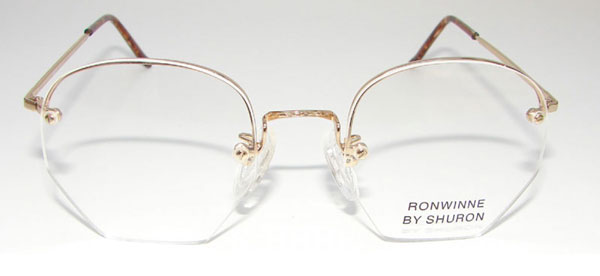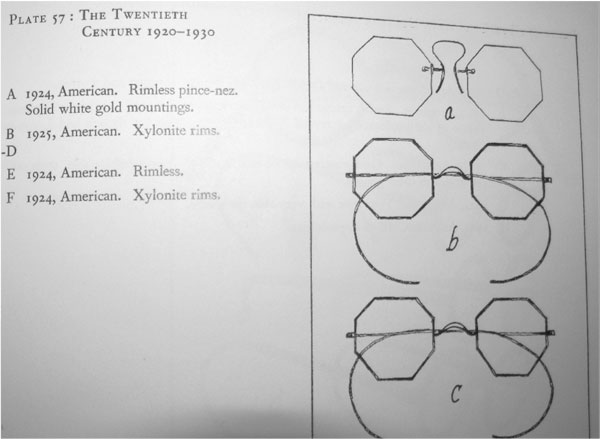Normally, in my Hindsight columns, I like to share a particular piece of optical history, tracing the origins of a frame design or style and assessing its' impact on American culture and history. This month, I'll be taking a similar, albeit slightly different approach. Rather than elaborate on history, I'll be looking at a mystery: The origins of octagonal eyeglass lenses.
Any collector who's ever browsed an antique store, dug through optical dead stock, or who fitted glasses prior to the 1960s knows what I'm talking about. The shape, in most instances (though not all) was not perfectly octagonal, but rounded at the top with sloping edges at the bottom that made the lens resemble a stop sign. For a long time, the genesis of the shape has interested me; even in the absence of historical documentation, we can see the appeal or origins of various other lens shapes or styles. Round frames permitted opticians to easily correct astigmatism by rotating the lens. Round as well as oval frames helped to reduce edge thickness for high-powered myopes; it was also briefly believed that, since they mimicked the shape of the eye, oval lenses would be more efficient than other shapes. There appears to be no practical design purpose behind the octagon, though, from an age when glasses were designed almost exclusively for practicality. Perhaps the only apparent practical benefit is the rounded top, but, as I mentioned earlier, some octagonal lenses from the era were perfect octagons, while virtually all of them had incredibly angular bottoms.

The traditional octagon shape, as still manufactured by Shuron.
So, where did they come from?
For the most part, large portions of my articles are made up of my own knowledge of optical history, with some super-periphery research conducted to fill in the light gaps here and there; more often than not, that research takes the form of little more than Google-imaging some pictures or asking a friend or colleague a single question. This month, though, I undertook a full-on quest, asking numerous individuals with combined centuries of historical optical knowledge about the origins of octagonal glasses. Without their assistance, you wouldn't be reading this, and full credit is given at the end of this article.
So, here we go. The originator of octagonal eyeglasses as they would appear in the 20th century first appeared in the first-quarter of the 1800s. Prior to that period, virtually all lenses were rounded (the somewhat popular image of Ben Franklin wearing rectangular glasses is historically inaccurate). If documentation exists anywhere as to the origins of branching out beyond round lenses, it has either been lost to time or lay buried at the bottom of a drawer or deep in the archives of some university. Though eight sided, the octagonal frames of the 1800s, like most frames of the era, were extremely small and had shallow B-measurements, making them less resemble stop signs than edgy eggs. The style had apparently caught on by the Civil War, from which we have numerous examples of both corrective lenses as well as medical glasses—tinted lens of various colors and shades believed by the doctors of the era to help alleviate the symptoms of various maladies and conditions from syphilis to bloodletting. We see the style dropping off in the post-Civil War years, being quickly and efficiently supplanted by oval lenses.

Selection from Fashions in Eyeglasses, courtesy of Mark Mattison-Shupnick.
As quickly as octagonal lenses fell out of favor, they reappeared. Richard Corson's "Fashions in Eyeglasses" contains illustrations of multiple, perfectly octagonal frames dating from the first half of the 1920s. The octagon as we know it today shape had come into popularity at least as early as 1931, when steel tycoon Ernest Weir was pictured on the cover of Life magazine sporting a pair. To look at historical photos, the shape's zenith of popularity seems to have been between the 1940s and 1960s; during that time, we see it appearing on a large number of prominent, bespectacled Americans, ranging in socioeconomic status and profession from bandleader Glenn Miller to civil rights activist Rosa Parks to gangster Enoch Johnson.

(L to R) Enoch Johnson, Glenn Miller and Rosa Parks.
Octagons appear to have been a casualty of the zyl craze of the 60s, disappearing along with rimless and semi-rimless glasses. Although wire-rimmed octagons existed, they appear to be the exception rather than the rule, and many of the examples I've come across seem to date later to the hippie era.
Unlike many other retro styles, octagons have yet to enjoy a great comeback since they initially fell out of favor; outside of period films, the last prominent appearance of octagonal frames appears to be in the 1981 horror musical, Shock Treatment. It is perhaps the most difficult lens shape to find today; in keeping with its' history, most octagonal frames available now are rimless or semi-rimless. Apart from a number of "old school" manufacturers (such as Shuron) and luxury lines (like Berkshire Chase), it's virtually impossible to find mass-marketed octagonal lenses. From a cosmetic standpoint, it's a shame, because the shape would flatter several face types and, because, hey, it's pretty cool, right?
This article contains far less information than I'd like for it to, and rather than end with a conclusion, I'd like to end it with an invitation. If anyone reading this has information on the history of octagonal lenses, do please write. What led to their rise in popularity in the 20s and 30s? Was there any practical idea behind their implementation, or did people just think they looked cool and different? This unique and fascinating entry in optical history deserves to be fully explored and examined.
Special thanks for the input, research, advice and assistance of Mark Mattison-Shupnick, Dick Whitney, Ed Welch, Moss Lipow, and David A. Fleishman.

Preston Fassel was born in Houston, Texas and grew up between St. Charles, Missouri and Broken Arrow, Okla.
In 2009, Preston graduated Summa Cum Laude with a degree in Liberal Arts. In 2011, he graduated Cum Laude from Sam Houston State University with a Bachelor's of Science.
Preston currently works as an Optician in the Houston area. His interest in the history of eyewear goes back to his time in high school, when he developed an interest in all things vintage.
In addition to his writing for The 20/20 Opticians Handbook and 20/20 Magazine, Preston is a featured writer for Rue Morgue Magazine, where he reviews of horror and science-fiction DVDs. His fiction writing has been featured three times in Swirl magazine, the literary arts journal of Lone Star College and Montgomery County. He is the author of the definitive work on the life of British horror actress Vanessa Howard, Remembering Vanessa, which appeared in the Spring 2014 edition of Screem Magazine.












